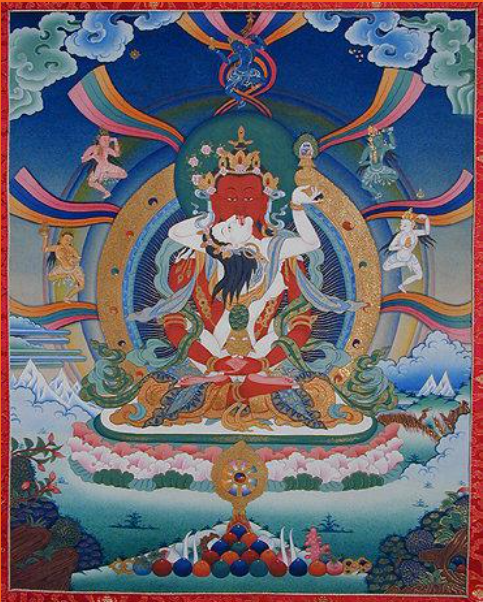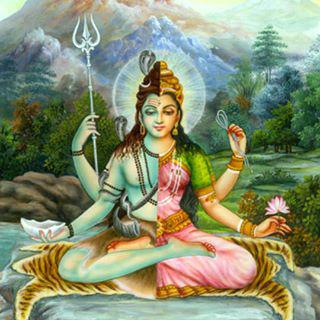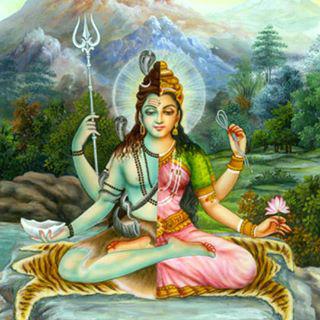What is Tantra ?
Although it has multiple meanings, the word "Tantra" can be translated as "rules". Its root is"Tant", which means Tender, and also means "to weave". Hence, it directly refers to a certain quality of relationship.
It is a spiritual current originating in the Himalayan-Indian region. It covers a set of texts, doctrines, rituals, yogic practices and initiation methods which have penetrated most branches of Hinduism, Taoism and Buddhism.
Tantra being such an ancient philosophy, it is difficult to determine its origins. However, it is widely admitted that Tantra would date back to the 7th or 5th century BC, depending on the sources.
In this discipline, the universe is considered to be founded on two opposing and complementary principles. They are symbolized by the masculine (Shiva - Awareness) and feminine (Shakti - Energy) couple.
It is a path of total transformation of the human being, which stimulates the body and the five senses. In order to reach an awakening of consciousness, a state of plenitude, Tantra invites us to activate the masculine and feminine energies within, in order to unite them. Tantra is also an invitation to one to observe and welcome all that is and goes right through ourselves in order to untie the bodily, emotional, mental and behavioral knots within.
Although it has multiple meanings, the word "Tantra" can be translated as "rules". Its root is"Tant", which means Tender, and also means "to weave". Hence, it directly refers to a certain quality of relationship.
It is a spiritual current originating in the Himalayan-Indian region. It covers a set of texts, doctrines, rituals, yogic practices and initiation methods which have penetrated most branches of Hinduism, Taoism and Buddhism.
Tantra being such an ancient philosophy, it is difficult to determine its origins. However, it is widely admitted that Tantra would date back to the 7th or 5th century BC, depending on the sources.
In this discipline, the universe is considered to be founded on two opposing and complementary principles. They are symbolized by the masculine (Shiva - Awareness) and feminine (Shakti - Energy) couple.
It is a path of total transformation of the human being, which stimulates the body and the five senses. In order to reach an awakening of consciousness, a state of plenitude, Tantra invites us to activate the masculine and feminine energies within, in order to unite them. Tantra is also an invitation to one to observe and welcome all that is and goes right through ourselves in order to untie the bodily, emotional, mental and behavioral knots within.

The West became interested in this practice very late, especially at the end of the 20th century, thanks to the teachings of the spiritual master Osho and Margot Anand, who led the first neo Tantra groups in India.
A Buddhist representation of tantric union
Although it has multiple meanings, the word "Tantra" can be translated as "rules". Its root is"Tant", which means Tender, and also means "to weave". Hence, it directly refers to a certain quality of relationship.
It is a spiritual current originating in the Himalayan-Indian region. It covers a set of texts, doctrines, rituals, yogic practices and initiation methods which have penetrated most branches of Hinduism, Taoism and Buddhism.
Tantra being such an ancient philosophy, it is difficult to determine its origins. However, it is widely admitted that Tantra would date back to the 7th or 5th century BC, depending on the sources.
In this discipline, the universe is considered to be founded on two opposing and complementary principles. They are symbolized by the masculine (Shiva - Awareness) and feminine (Shakti - Energy) couple.
It is a path of total transformation of the human being, which stimulates the body and the five senses. In order to reach an awakening of consciousness, a state of plenitude, Tantra invites us to activate the masculine and feminine energies within, in order to unite them. Tantra is also an invitation to one to observe and welcome all that is and goes right through ourselves in order to untie the bodily, emotional, mental and behavioral knots within.
The West became interested in this practice very late, especially at the end of the 20th century, thanks to the teachings of the spiritual master Osho and Margot Anand, who led the first neo Tantra groups in India.
Westerners have often been criticized for having kept from Tantra only ritualized sexual practices which ultimate goal is to merge into the relationship. However, it turns out that this aspect of Tantra suits us rather well since we, Westerners, live mainly through the upper body (mind and all that derives from it: intellectualization, conceptualization, mental representations, fantasies ...) while denying the importance of listening and feeling the body.
It provides an opportunity to de-demonize matter, to get out of dualistic visions of sexuality and, to a greater extent, of Life (sex VS love, life VS death, spirituality VS sexuality, etc.) by freeing oneself from mental representations (fantasies) in order to fully enter the relationship to oneself and to the other through a direct bias.
However, reducing Tantra to sexuality is a mistake.
But Tantra covers much wider fields than that of sexuality, and it can be experienced in a thousand and one ways. It is a state of Being. It allows us to grasp how we actually are more than our body, how the relationship is larger than what is said and seen. We understand that the pleasure of the senses is not reduced to the physical orgasm located in the sexual organs. It can be much larger, and set the whole body on fire in what is called a Tantric Orgasm.
Starting from the principle that we are all connected - beings, animals, plants - Tantric sharing can just as well be experienced with a partner, a tree, an energy or even the entire Universe. In order to do so, Tantra asks us to get out of our hierarchical vision of the world and social relations.
Tantra invites us to accept Life in its entirety in order to embrace all that is in us and around us without judgment. Thus, the knots that hinder us come undone, allowing us to deploy a quality of relationship with all that is.
It is, ultimately, a way to connect heaven and earth within, to spiritualize sexuality and matter or to materialize spirituality.
Bien qu'il possède de multiples significations, le mot "tantra" a pour racine "tant" (tendre) et signifie "tisser", il renvoie directement à une certaine qualité de relation.
C'est un courant spirituel originaire de la région himalayo-indienne. Il recouvre un ensemble de textes, de doctrines, de rituels, de pratiques yogiques et de méthodes initiatiques qui ont pénétré la plupart des branches de l'hindouisme, du taoïsme et du bouddhisme.
Sa source est difficile à dater tant elle est ancienne mais les premiers documents écrits dateraient du VIIème siècle ou du Vème sicèle avant Jésus-Christ selon les sources.
Dans cette discipline, on considère comme base de l'univers deux principes symbolisés par le couple masculin (Shiva) et féminin (Shakti).
C'est une voie de transformation totale de l'être humain, qui passe par le corps et les cinq sens. Pour arriver à cet éveil de conscience, cette plénitude,le tantra nous invite à activer les énergies corporelles masculines et féminines en nous et les unir afin de réveiller la kundalini – énergie sexuelle de vie - située à la base de la colonne vertébrale pour la faire circuler dans tout le corps, notamment à travers les sept chakras (centres énergétiques) tout en dénouant les noeuds corporels, émotionnels, mentaux et comportementaux.

Tantric fusion of male and female energies
under the representation of the Hindu god Shiva and the goddess Shakti.
Partant du principe que nous sommes tous reliés - être, animaux, plantes - le partage tantrique peut aussi bien se vivre avec un partenaire, un arbre, une énergie voire l'Univers entier. Il nous demande pour cela de sortir de notre vision hiércharichique du monde et des rapports sociaux.
"If you are aware you will realize that sexuality is not just sex.
Sex is the outer layer; deep under, there is love...
Even deeper under, there is prayer...
And always deeper, there is the divine.
Sex can become a cosmic experience. So we call it Tantra."
Osho
Westerners have often been criticized for having kept from Tantra only ritualized sexual practices which ultimate goal is to merge into the relationship. However, it turns out that this aspect of Tantra suits us rather well since we, Westerners, live mainly through the upper body (mind and all that derives from it: intellectualization, conceptualization, mental representations, fantasies ...) while denying the importance of listening and feeling the body.
Tantra allows us to become fully aware of our body and of the energies and rhythm that animate it. It provides an opportunity to de-demonize matter, to get out of dualistic visions of sexuality and, to a greater extent, of Life (sex VS love, life VS death, spirituality VS sexuality, etc.) by freeing oneself from mental representations (fantasies) in order to fully enter the relationship to oneself and to the other through a direct bias.
Westerners have often been criticized for having kept from Tantra only ritualized sexual practices which ultimate goal is to merge into the relationship. However, it turns out that this aspect of Tantra suits us rather well since we, Westerners, live mainly through the upper body (mind and all that derives from it: intellectualization, conceptualization, mental representations, fantasies ...) while denying the importance of listening and feeling the body.
"If you are aware you will realize that sexuality is not just sex.
Sex is the outer layer; deep under, there is love...
Even deeper under, there is prayer...
And always deeper, there is the divine.
Sex can become a cosmic experience. So we call it Tantra."
Osho
"If you are aware you will realize that sexuality is not just sex.
Sex is the outer layer; deep under, there is love...
Even deeper under, there is prayer...
And always deeper, there is the divine.
Sex can become a cosmic experience. So we call it Tantra."
Osho

However, reducing Tantra to sexuality is a mistake.
Indeed, Tantra covers much wider fields than that of sexuality, and it can be experienced in a thousand and one ways. It is a state of Being. It allows us to grasp how we actually are more than our body, how the relationship is larger than what is said and seen. We understand that the pleasure of the senses is not reduced to the physical orgasm located in the sexual organs. It can be much larger, and set the whole body on fire in what is called a Tantric Orgasm or Energetic Orgasm.
Starting from the principle that we are all connected - beings, animals, plants - Tantric sharing can just as well be experienced with a partner, a tree, an energy or even the entire Universe. In order to do so, Tantra asks us to get out of our hierarchical vision of the world and social relations.
Tantra invites us to accept Life in its entirety in order to embrace all that is in us and around us without judgment. Thus, the knots that hinder us come undone, allowing us to deploy a quality of relationship with all that is.
It is, ultimately, a way to connect heaven and earth within, to spiritualize sexuality and matter or to materialize spirituality.
Tantra allows us to become fully aware of our body and of the energies and rhythm that animate it. It provides an opportunity to de-demonize matter, to get out of dualistic visions of sexuality and, to a greater extent, of Life (sex VS love, life VS death, spirituality VS sexuality, etc.) by freeing oneself from mental representations (fantasies) in order to fully enter the relationship to oneself and to the other through a direct bias.
However, reducing Tantra to sexuality is a mistake.
But Tantra covers much wider fields than that of sexuality, and it can be experienced in a thousand and one ways. It is a state of Being. It allows us to grasp how we actually are more than our body, how the relationship is larger than what is said and seen. We understand that the pleasure of the senses is not reduced to the physical orgasm located in the sexual organs. It can be much larger, and set the whole body on fire in what is called a Tantric Orgasm.
Tantric fusion of male and female energies
under the representation of the Hindu god Shiva and the goddess Shakti.
Tantric fusion of male and female energies
under the representation
of the Hindu god Shiva and the goddess Shakti.
Starting from the principle that we are all connected - beings, animals, plants - Tantric sharing can just as well be experienced with a partner, a tree, an energy or even the entire Universe. In order to do so, Tantra asks us to get out of our hierarchical vision of the world and social relations.
Tantra invites us to accept Life in its entirety in order to embrace all that is in us and around us without judgment. Thus, the knots that hinder us come undone, allowing us to deploy a quality of relationship with all that is.
It is, ultimately, a way to connect heaven and earth within, to spiritualize sexuality and matter or to materialize spirituality.
Interested in knowing more about Tantra?
Subscribe to Men's Hearts newsletter: click here
Copyright © 2023 Men's Heats by Guillaume Douceré EI - Legal notices - Sitemap
_(1)_1.png?v=1hv7t1j)
_1.jpg?v=1husmil)
_1.jpg?v=1havnp3)